Click
Here to return to the previous page
Paul Sparks
- Online English Lesson Plans, Lesson Material and Ideas for "Culture of
English Speaking Countries Lessons", Xiangtan Normal University...
WESTERN CULTURE AND SOCIETY: THE UNITED KINGDOM (UK) -
British Money, Banking and E-Business
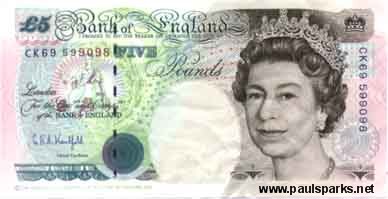
British Currency:
The pound symbol '£' is normally indicated by using "UKP" or
"GBP" where not available on the keyboard. When talking about
British pence, therefore, the codes are GBp and UKp. The Decimal currency
(Pound Sterling) was introduced on February 15th 1971. (The previous system
of money was known as "Pounds, Shillings and Pence")
"The Bank of
England" is the sole issuer of currency notes in England and Wales, and
although Scottish and Northern Irish banks issue their own notes. (Coins are
issued by the "Royal Mint" on behalf of the Treasury, and is not a
responsibility of the Bank of England.)
Bank of England
Banknotes: The Bank of England has been issuing
bank notes for over 300 years. Gaining and maintaining public confidence in
the currency or, to put it another way, preserving its value and integrity,
is a key role of the Bank of England and one which is essential to the
proper functioning of the economy. The Bank must ensure that the currency
maintains a stable level, in other words, that the value of its notes is not
decreased by inflation. This is the role of the monetary policy, which is
one of the Bank's main responsibilities. It must also guarantee the
integrity of its notes; making sure that they are as difficult as possible
to counterfeit, that they are readily and securely available to banks and
building societies upon demand, and subject to these constraints, that they
are attractive and easily identifiable both to the human eye and to note
reading machines.
Cash:
Britain uses "pounds" and "pence" as its currency, with
100 pence per pound (Pound Sterling). The name pound sterling comes from an
old pound weight of a metal called Sterling. There are eight denominations
of coin: 1p, 2p, 5p, 10p, 20p, 50p, £1 and £2. There are four
denominations of bank note: £5, £10, £20 and £50.
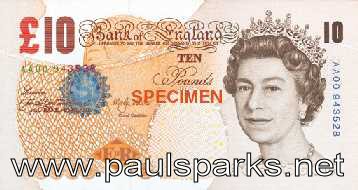

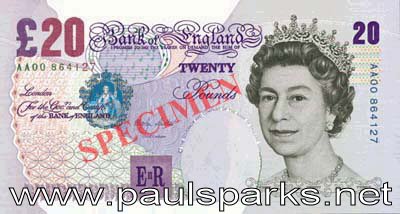
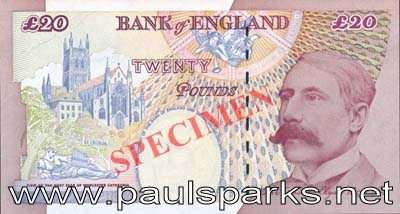
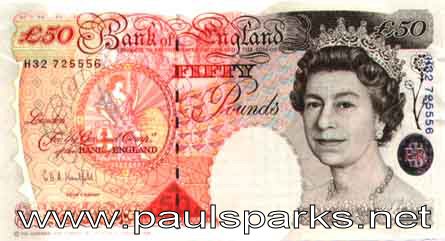
Interesting Money Facts
!!:
British money has many nicknames. One Pound Sterling is known as a
"Quid", £1000.00 is known as a "Grand", A 1p coin is
called a "Penny", £5.00 is generally known as a "Fiver"
and £10.00 is known as a "Tenner".
When paying for
something the other party can legally refuse to accept your payment if you
use more than ten coins !!
All the British coins
have pictures of the Queen on the back, along with her title and the coin's
date of impression.
The Bank of England no
longer prints £1 notes (coins are used instead), but the Royal Bank of
Scotland still does. However, if you find one in London, the only place you
can take it to is a bank. Although it is legal tender, very few people have
ever seen it.
The fiver is very
colourful, the reverse of the fiver has an imprint about George Stephenson
who built the steam locomotive "Rocket" in 1829.
The Twenty Pound note is
the most widely available British note.
All the Bank Of England
notes have the light coloured oval center bottom: a security watermark of
the Queen's head lives here. You'll also notice the dashed line running top
to bottom just to the left of the oval: this is a metallic security thread
woven into the note. There are other security features, but these two are
the most widely known, so if you get a note with no watermark and no thread,
don't accept it!
Sales tax, known as VAT:
"Value Added Tax" - is applied to most things at a rate of
17.5%. Notable exceptions are children's clothing and food. Sales tax can be
reclaimed as a business expense in some cases, and overseas visitors are
able to claim the sales tax back from the government on production of the
receipts and goods when they leave the country. The prices shown in shops
always include the VAT.
Credit Cards (known as
"Plastic"): A credit card is a thin
plastic card, it contains identification information, normally a signature,
and authorizes the person named on it to charge purchases or services to
their bank account. The charges are billed periodically. Today, the
information on the card is read by automated teller machines (ATMs) -
(Normally called "cash machines" in the UK - or "The hole in
the wall"), store readers, and bank and Internet computers.
According to the
Encyclopedia Britannica, the use of credit cards originated in the United
States during the 1920s, when individual companies, such as hotel chains and
oil companies, began issuing them to customers for purchases made at those
businesses. This use increased significantly after World War II.
The first universal
credit card (one that could be used at a variety of stores and businesses)
was introduced by "Diners Club, Inc.", in 1950. With this system,
the credit-card company charged cardholders an annual fee and billed them on
a monthly or yearly basis. Another major universal card was established in
1958 by the American Express company.
Later came the bank
credit-card system. Under this plan, the bank credits the account of the
merchant as sales slips are received (this meant merchants were paid
quickly, something they loved!) and assembles charges to be billed to the
cardholder at the end of the billing period. The cardholder, in turn, pays
the bank either the entire balance or in monthly installments with interest
(sometimes called carrying charges).
The first bank to use
the system was in America, the system was called "BankAmericard",
which was started on a statewide basis in 1959 by the Bank of America in
California. This system was licensed in other states starting in 1966, and
was renamed "Visa" in 1976.
Other major bank cards
followed, including "MasterCard", formerly Master Charge. In order
to offer expanded services, such as meals and lodging, many smaller banks
that earlier offered credit cards on a local or regional basis formed
relationships with large national or international banks. Visa and
MasterCard are now the most widely used credit cards in the UK.
When you buy something
on a credit card the cashier swipes your credit card through a reader, at
the point-of-sale (POS) computer, the terminal dials a telephone number via
a modem to call an acquirer. An acquirer is an organisation that collects
credit-authentication requests from merchants and provides the merchants
with a payment guarantee. The purchase will then be given an authorisation
number. The money will then be taken from the customers card.
Annual fee - A yearly
charge similar to a membership fee. Many companies offer "no annual
fee" cards today, and lenders who do charge annual fees are often
willing to waive them to keep your business.
Finance charge - The
amount you pay to use credit. Besides interest costs, this may include other
charges such as cash-advance fees, which are charged against your card when
you borrow cash from the lender.
Grace period - A time
period, usually about 25 to 30 days, during which you can pay your
credit-card bill without paying any finance charge (interest). Under almost
all credit-card plans, the grace period only applies if you pay your balance
in full each month. It does not apply if you carry a balance forward. Also,
the grace period does not apply to cash advances.
Annual percentage rate
(APR) - The yearly percentage rate of the finance charge. Interest rates on
credit-card plans change over time. Some of these adjustments are tied to
changes in other interest rates, such as the prime rate or the Treasury Bill
rate, and are called variable-rate plans. Others are not explicitly tied to
changes in other interest rates and are called fixed-rate plans.
Introductory rate - A
temporary, lower APR that usually lasts for about six months before
converting to the normal fixed or variable rate. Some credit cards, such as
American Express, require you to pay off all of your charges each month. As
a benefit, they usually have no finance charge. Most cards, including Visa
and MasterCard, offer what is known as revolving credit. This means they let
you carry a balance, on which they charge interest (finance charges), and
they require you to make a minimum payment each month.
Commerce:
Before we get into a complete discussion of e-commerce, it is helpful to
have a good mental image of plain old commerce first. If you understand
commerce, then e-commerce is an easy extension.
Merriam-Webster's
Collegiate Dictionary defines commerce as follows:
Commerce is, quite
simply, the exchange of goods and services, usually for money. We see
commerce all around us in in millions of different forms. When you buy
something at a shop or department store you are participating in commerce.
According to eMarketer
the biggest product categories include:
Computer products
(hardware, software, accessories)
Books
Music
Financial Services
Entertainment
Home Electronics
Apparel
Gifts and flowers
Travel services
Toys
Tickets
Information
"e-business":
In its simplest sense, e-business is the use of Internet technologies to
improve and transform key business processes. Most UK companies understand
this and have begun the evolution from traditional business practices to
e-business. Many are well on their way. They have begun to Web-enable
processes to strengthen customer service operations, streamline supply
chains and reach existing and new customers.
The accessibility and
broad reach of the Internet have forever changed customers' expectations
regarding support and response. They expect accurate, round-the-clock
service. Hence the requirement for a massively scalable, reliable and secure
electronic foundation which includes reliable and available servers,
industry-leading software and middleware, and worldwide consulting services
from experts with industry-specific knowledge.
Why e-business?:
In a few short years, e-business has gone from an simple idea to reality.
The main advantage is that it works for everyone: consumers, businesses and
governments. The primary values of e-business - cost savings, revenue growth
and customer satisfaction, are proving to be just the beginning. The key to
success is finding a way to give customers what they want without the
expense of traditional business operations.
e-commerce:
No other aspect of e-business has gained more attention than e-commerce.
Taking advantage of e-commerce is much more than simply opening up a new,
online sales channel. It's about using technology to streamline your
business model, creating savings, and increasing efficiency. It's about
lowering costs and establishing closer, more responsive relationships with
your customers, suppliers and partners.
e-commerce has evolved
from consumers conducting basic transactions on the Web, to a complete
re-organisation of the way partners, suppliers and customers interact. Now
you can link dealers and suppliers online, reducing both time and paperwork.
You can streamline your financial relationships with customers and suppliers
by Web-enabling billing and payment systems.
The advantages of
E-commerce:
Lower transaction costs:
If an e-commerce site is implemented well, the web can significantly lower
both order-taking costs up front and customer service costs after the sale
by automating processes.
Larger purchases per
transaction: "Amazon.com" offers a
feature that no normal store offers. When you read the description of a
book, you also can see "what other people who ordered this book also
purchased". That is, you can see the related books that people are
actually buying. Because of features like these it is common for people to
buy more books that they might buy at a normal bookstore.
Integration into the
business cycle: A Web site that is
well-integrated into the business cycle can offer customers more information
than previously available. For example, if Dell tracks each computer through
the manufacturing and shipping process, customers can see exactly where
their order is at any time. This is what FedEx did when they introduced
on-line package tracking - FedEx made far more information available to the
customer.
People can shop in
different ways: Traditional mail order
companies introduced the concept of shopping from home in your pajamas, and
e-commerce offers this same luxury. New features that web sites offer
include:
-
The ability to build
an order over several days
-
The ability to
configure products and see actual prices
-
The ability to
easily build complicated custom orders
-
The ability to
compare prices between multiple vendors easily
-
The ability to
search large catalogs easily
Larger catalogs:
A company can build a catalog on the web that would never fit in an ordinary
mailbox. For example, Amazon sells 3,000,000 books. Imagine trying to fit
all of the information available in Amazon's database into a paper catalog!
Improved customer
interactions: With automated tools it is
possible to interact with a customer in richer ways at virtually no cost.
For example, the customer might get an email when the order is confirmed,
when the order is shipped and after the order arrives. A happy customer is
more likely to purchase something else from the company.
It is these sorts of advantages that create the buzz that surrounds
e-commerce right now.
There is one final point
for e-commerce that needs to be made. E-commerce allows people to create
completely new business models. In a mail order company there is a high cost
to printing and mailing catalogs that often end up in the trash. There is
also a high cost in staffing the order-taking department that answers the
phone. In e-commerce both the catalog distribution cost and the order taking
cost fall toward zero. That means that it may be possible to offer products
at a lower price, or to offer products that could not be offered before
because of the change in cost dynamics.
However, it is important
to point out that the impact of e-commerce only goes so far. Mail order
sales channels offer many of these same advantages, but that does not stop
your town from having a mall. The mall has social and entertainment aspects
that attract people, and at the mall you can touch the product and take
delivery instantly. E-commerce cannot offer any of these features. The mall
is not going to go away anytime soon...
ECONOMIC ACRONYMS
CAP Common
Agricultural Policy
CBI Confederation of British Industry
CTE Committee on Trade and Environment
EEA European Economic Area
EU European Union
FDI Foreign Direct Investment
GATS General Agreement on Trade in Services
GATT General Agreement on Tariffs and Trade
ILO International Labour Organisation
IMF International Monetary Fund
MEA Multilateral Environmental Agreements
OECD Organisation for Economic Cooperation and Development
RTA Regional Trade Agreements
TBT Technical Barriers to Trade
TRIMS Trade Related Investment Measures
TRIPS Trade Related Aspects of Intellectual Property
UN United Nations
UNCTAD United Nations Conference on Trade and Development
UNEP United Nations Environment Programme
UNICE Union of Industrial and Employers’ Confederations of Europe
WCO World Customs Organisation
WIPO World Intellectual Property Organisation
WTO World Trade Organisation
|